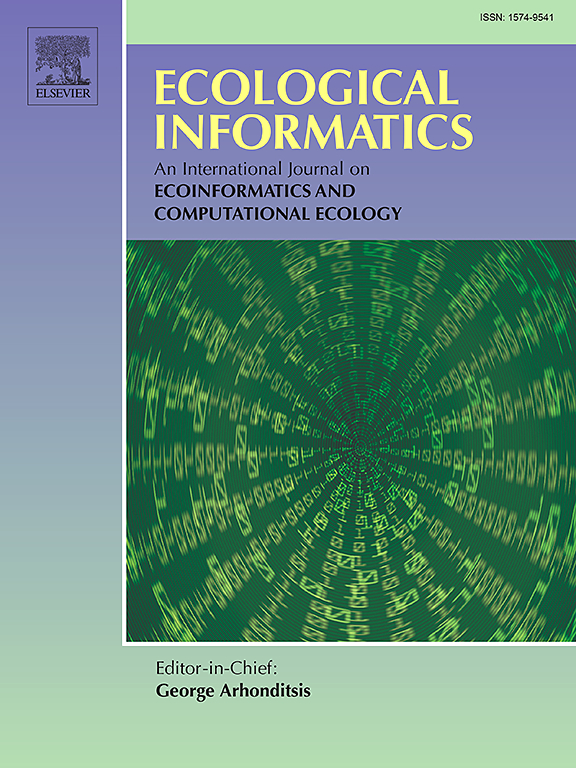观测和模型导出的训练变量之间的共线性对河口藻类种类分布模型的影响
IF 7.3
2区 环境科学与生态学
Q1 ECOLOGY
引用次数: 0
摘要
需要对生物在时间和空间上的分布进行预测,以减轻与环境条件变化有关的风险。这些预测通常是使用相关的物种分布模型(SDMs)产生的,该模型将环境变量与物种的存在或丰度联系起来。生物复杂性使得SDM的构建具有挑战性,因为用于训练SDM的环境变量之间的共线性可能增加模型参数的不确定性。为了分析共线性对sdm的影响,我们(1)在美国切萨皮克湾(Chesapeake Bay)常见的7种河口藻类中使用不同程度的共线性训练sdm,(2)识别环境预测因子,(3)使用两种统计技术(广义线性模型和回归树)研究它们与物种存在的关系。我们贡献的新颖之处在于,我们的分析同时使用了环境原位观测和由机制模型生成的环境信息。环境变量在现场观测(165个相关中的32个)和机制模式输出(120个相关中的12个)中都表现出很强的共线性。为了确定这些变量之间的共线性如何影响我们的SDM结果,我们删除了超过特定相关阈值的环境变量。我们发现,使用这两种不同类型的训练信息(即观察到的与建模的)会影响(1)最优预测集,(2)环境变量与藻类存在之间的关联,以及(3)模型的预测技能。水温通常被选为一个重要的预测指标。环境变量与藻类存在之间强烈的正相关或负相关关系不会受到所使用的训练信息类型的实质性影响。尽管去除共线性可能会导致检测到新的重要预测因子,但也可能导致SDM预测技能略有下降(~ 5%),具体取决于感兴趣的种类和训练信息的类型。我们的研究结果表明,主要的环境预测因子依赖于SDM构建中使用的物种特征和训练信息类型,并突出了解释这些SDM预测的环境条件与物种存在之间的关联的挑战。这些见解有助于我们更好地了解对这些藻类物种至关重要的环境条件,从而通过揭示哪些原位观察对准确预测这些河口藻类的繁殖至关重要,从而优化监测工作。本文章由计算机程序翻译,如有差异,请以英文原文为准。

The effect of collinearity between observed and model derived training variables on estuarine algal species distribution models
Forecasts of organism distributions in time and space are needed to mitigate risks associated with changes in environmental conditions. These forecasts are often generated using correlative species distribution models (SDMs) that relate environmental variables to species presence or abundance. Biological complexity makes the construction of SDMs challenging because the collinearity between the environmental variables used to train the SDM may increase model parameter uncertainty. To analyze the effect of collinearity on SDMs, we (1) train SDMs for seven estuarine algal species commonly observed in the Chesapeake Bay (U.S.A.) using different levels of collinearity in the training information, (2) identify the environmental predictors, and (3) study their association with species presence using two statistical techniques (generalized linear models and regression trees). The novelty of our contribution is that our analysis uses both environmental in situ observations and environmental information generated by a mechanistic model. The environmental variables show strong collinearities in both the in situ observations (32 out of the total of 165 correlations) and mechanistic model output (12 out of the total of 120 correlations). To determine how collinearity between these variables affect our SDM results, we remove environmental variables that surpass a specific correlation threshold. We find that using these two different types of training information (i.e., observed vs. modeled) affects (1) the optimal set of predictors, (2) the associations between environmental variables and algal presence, and (3) the model’s predictive skill. Water temperature is generally selected as an important predictor. Strong positive or negative associations between environmental variables and algal presence are not substantially impacted by the type of training information used. Although removing collinearities may result in the detection of new important predictors, it may also result in a slight decrease ( 5 %) of the SDM prediction skill, depending on the species of interest and type of training information. Our findings suggest that the main environmental predictors rely on both the species characteristics and training information type used in SDM construction, and highlight the challenge of interpreting the associations between environmental conditions and species presence predicted by these SDMs. These insights help us to better understand the environmental conditions of importance to these algal species and hence optimize monitoring efforts by revealing which in situ observations are vital to accurately forecast blooms of these estuarine algae.
求助全文
通过发布文献求助,成功后即可免费获取论文全文。
去求助
来源期刊

Ecological Informatics
环境科学-生态学
CiteScore
8.30
自引率
11.80%
发文量
346
审稿时长
46 days
期刊介绍:
The journal Ecological Informatics is devoted to the publication of high quality, peer-reviewed articles on all aspects of computational ecology, data science and biogeography. The scope of the journal takes into account the data-intensive nature of ecology, the growing capacity of information technology to access, harness and leverage complex data as well as the critical need for informing sustainable management in view of global environmental and climate change.
The nature of the journal is interdisciplinary at the crossover between ecology and informatics. It focuses on novel concepts and techniques for image- and genome-based monitoring and interpretation, sensor- and multimedia-based data acquisition, internet-based data archiving and sharing, data assimilation, modelling and prediction of ecological data.
 求助内容:
求助内容: 应助结果提醒方式:
应助结果提醒方式:


